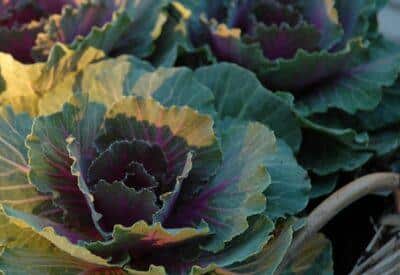
Image source: About.com
When it comes to gardening, I have a hard time waiting for spring. In January I start to dream about planting. In February, I’m researching plants, designing my garden, and writing up a cost estimate for my newest growing endeavors. By March, I’m chomping at the bit, eager to get my pots started. But I don’t own a plot of land where I can plant. Rather than resign myself to wistfully admiring other’s gardens, I’ve tackled vegetable container gardening in the past and this year is no different. Small space may require a bit more work to encourage cold-weather vegetables to grow and produce, but it’s certainly an option and one I love!
Containers
Some of the first crops of the season are broccoli, cabbage and cauliflower. While these plants respond best when planted directly into the ground, they can manage well in pots if cared for properly. To start out, you’ll need a correct pot size for each plant. Broccoli and cauliflower generally need larger pots (at least five gallons per plant and between 12 to 16 inches deep). Cabbage can manage in a two gallon pot. Ensure there is at least one drainage hole in the bottom of the pot. While water, and plenty of it, is essential to rapidly growing plants, too much stagnant water can smother a plant. Generally, the larger the pot size, the better it is for the plant. Larger containers help quell soil temperature fluctuations, and the more room there is for soil, water and roots, the better the crop will be. When it comes to pot size, don’t skimp!
Soil
Once you have your containers chosen, you’ll need to think about what you’re going to fill them with. Good vegetable growing soil needs to provide adequate drainage and supply nutrients to your plants. It’s generally recommended to start out your pots with a good quality potting soil mix. These mixes include perlite or sand (for drainage) and peat, or composted bark (for nutrition). If you desire to mix your own soils, do some research online or at your library or bookstore, as there is a lot of good information out there on creating excellent potting soil. Alternatively, you can get by just fine with purchasing a bag of quality potting soil from your local plant nursery.
Fertilizer
While potting soil comes with its own nutrients, it doesn’t tend to last the entire growing season due to tendency of the nutrients to wash out of the soil from the frequent watering. Plan to start fertilizing your plant sometime in the summer, close to the time the plant starts producing. Over-fertilizing is common, but not necessary, so watch your plants and experiment with how much and how often you give them extra food.
Watering
Your broccoli, cabbage and cauliflower plants will be very dependent on you for adequate water. Container plants go through a lot of water. Some water will drain out the bottom, especially if too much is given at one time, while other water will evaporate out the top. Stack on top of that the intense water needs of growing vegetable plants, and you can expect to water your plants every day.
Without A Doubt The Best Kept Secret In Self-Reliance Gardening…
Ed Smith shares that “There’s no wiggle room here; vegetable plants that don’t get enough water when they need it become stressed, and don’t produce as well. This means that a traditional container gardener has to be available to water the garden once a day – or more than once – every day” (Mother Earth News, April/May 2008). However, there is also another option: self-watering containers. These have a reservoir in the bottom that you fill with water. The soil then takes up enough water for the plant’s satisfaction. While these are available from plant nurseries, they’re also easy enough to construct yourself. Glance around online for instructions on how to make your own. Whether you use traditional pots or self-watering containers, watch your plants and you’ll soon know what they need. Container gardening can be intensive from time to time, but the results are worth it!
Now that you have your containers and soil, it’s time to take a look at the individual cold season crops. When purchasing plants or seeds for container gardens, look for ones that say “dwarf,” “compact” or “fast-maturing” as these are best suited for growing in smaller spaces.
1. Broccoli
Broccoli loves cool weather, lots of water, at least six hours of sunlight and rich soil. Start your seeds indoors about six weeks before the last spring frost. Once the plants are about four weeks old, harden them off (gradually get them used to the outdoors) and move them outside. Broccoli can also be planted in the late summer for a fall crop. You’ll need to start your seeds indoors 12-14 weeks before the first fall frost. Set them outside when they’re between four and six weeks old.
Story continues below video
Check your plants for worms. Water frequently and fertilize often. Adding compost, composted chicken manure or liquid fertilizer are excellent ways to meet broccoli’s high nutrient needs. You can pick your first harvest “when the florets around the edges of the head begin to show slight loosening, but when the beads in most of the crown are still tight” says Barbara Pleasant (Mother Earth News, August/September 2009). Cut the stems at a diagonal to deter water pooling and your plants rotting. If you choose a sprouting broccoli kind, then you’ll see repeat harvests, though each harvest will be smaller. You can eat your broccoli fresh in stir-fries, salads and more, or you can steam it and freeze it for future use.
2. Cabbage
Cabbage comes in a range of kinds, Green, Red, Savoy, Pointed, and Napa. Look for smaller, fast growing varieties for your container garden. They love fertile soil and lots of sun, so consider adding some compost to your potting soil and feeding throughout their growing season. Set your pots where they can receive direct sunlight for much of the day. You’ll need to start seeds indoors eight to 10 weeks before your area’s last spring frost. Once the seedlings are about six weeks old, you can harden them off and set them outside. If you want a fall crop, start seeds 12 to 14 weeks before the first fall frost. You can cut your first harvest when the heads feel firm. Cut high and clean and your plant may produce several smaller heads. Your cabbage will store nicely in the refrigerator for about two weeks. Enjoy fresh coleslaw or blanche and freeze it. Another alternative is to make nutrient and healthy bacteria rich fermented sauerkraut (not heat-treated). Enjoy!
3. Cauliflower
Cauliflower may be one of the most temperamental of the cool weather crops. Generally, it’s recommended to start plants in the summer for a late fall/winter harvest. If cauliflower gets hit with 80 degrees Fahrenheit temperatures while the heads are forming, small, poorly textured heads result. Look for fast-growing, early maturing plants for container gardens. Cauliflower loves fertile soil, so plan to feed your plants regularly. They also do not handle cramped spaces well (delivering smaller heads), so ensure you have a nice sized pot for each plant (at least five gallons and preferably bigger). In late spring or early summer, start your cauliflower seeds. Watch your plants for insect problems. Drench plants with a high-nitrogen fertilizer (like fish emulsion), every couple weeks as they grow. Once the head is formed and a nice size (don’t wait too long or the head will take on an unpleasant texture), use a sharp knife to harvest it. Cauliflower plants only produce one head, so you can pull and discard or compost the rest of the plant once you’ve harvested the head. Cauliflower will keep in the refrigerator for a number of weeks or you can blanch and freeze the florets. Enjoy in stir-fries, soups, and more!
When it comes to gardening in small spaces, cool-weather crops are certainly an option. Choose well-sized pots and containers for your plants, adhere to the seasonal growing recommendations, feed often, provide plenty of water and sun and you’ll be experiencing the joys of your first cool-weather crops this year!
Sign up for Off The Grid News’ weekly email and stay informed about the issues important to you
 Off The Grid News Better Ideas For Off The Grid Living
Off The Grid News Better Ideas For Off The Grid Living




